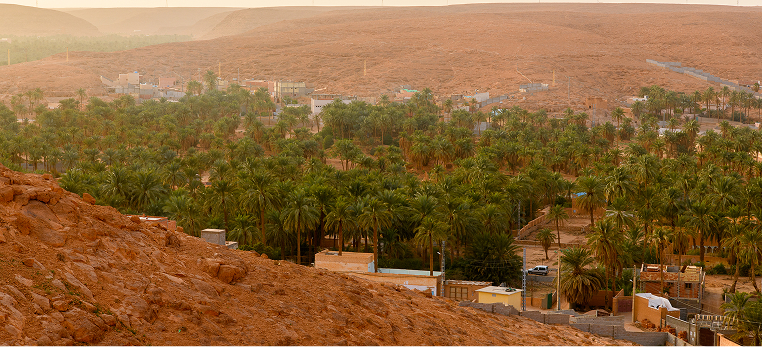Ghardaïa: A Charm to Discover with Your Own Eyes

Nestled in the heart of the Algerian Sahara, Ghardaïa is a city that leaves no one indifferent. Its unique architecture, demanding yet fascinating climate, and deeply rooted traditions make it a place like no other, where every visitor leaves with unforgettable memories.
A Strategic Geographical Location
Located 200 km from Laghouat, 300 km from Djelfa, 200 km from Ouargla, 800 km from Adrar, and 1,200 km from Tamanrasset, Ghardaïa is a key Saharan crossroads connecting various regions of Algeria. It is traversed by National Road 01, a vital route linking Algiers to Niger, making it an essential stop for desert travelers.
A Distinctive Saharan Climate
Living in Ghardaïa means adapting to an extreme climate. Winters can be surprisingly cold, with nighttime temperatures dropping to 1°C, while daytime highs reach 25°C, making this season ideal for visiting. Summers, on the other hand, are intense, with temperatures soaring up to 48°C. However, the shade of palm groves and the traditional earthen architecture of local homes help mitigate the heat. A northwesterly breeze brings relief in winter, while the sirocco wind sweeps through in summer. Despite these conditions, the locals have adapted their way of life to create a harmonious and comfortable existence in Ghardaïa.

A Haven of Oases and Palm Groves
A true green oasis in the heart of the desert, Ghardaïa’s palm groves are abundant with date palms, providing essential shade and a valuable agricultural resource. Here, dates are more than just a fruit—they are a treasure, a source of sustenance, and a deep-rooted tradition. During summer, these lush gardens become peaceful retreats where people gather to escape the scorching heat.

Iconic Architecture and Ksour
Ghardaïa is an architectural masterpiece. Its ksour—fortified villages built from earth—showcase the ingenuity of the Mozabite people, who designed cities perfectly adapted to their harsh environment. Walking through Ghardaïa’s narrow streets is like stepping back in time, where every house, square, and mosque tells a story.
Beni Isguen, renowned for its traditional auction market, reflects the community’s well-organized social structure. El Atteuf, the oldest ksar in the M’zab Valley, reveals winding alleys and centuries-old buildings. Taghardait, Bounoura, Melika, and Guerrara all contribute to this rich heritage, as does the more recent Ksar Tafilelt, a model of sustainable urban planning.
Listed as a UNESCO World Heritage Site, these ksour are not just relics of the past; they are still vibrant, inhabited spaces where tradition and modernity blend seamlessly.
Traditions, Culture, and Lifestyle
Culture is alive in every corner of Ghardaïa. Solidarity and mutual aid shape daily life, while local artisans continue age-old crafts. Handwoven carpets, intricately decorated pottery, and fine leatherwork highlight the craftsmanship of the Mozabite people.
Traditional clothing remains a strong cultural marker: women draped in white haïks and men wearing saroual loubia give the city a timeless elegance.
The local cuisine is equally rich in authenticity, featuring specialties like maghlouga, ouchou douiniw (date couscous), and rfiss mozabit, all deeply tied to the region’s culinary traditions.

The Ghardaïa Market: A Lively Spectacle
Nowhere embodies the spirit of Ghardaïa more than its market in Taghardait. Vibrant stalls overflow with spices and fabrics, and transactions unfold with a sense of respect and discipline, preserving a centuries-old trading tradition. This market is a true stage for local life, offering visitors an authentic experience.
An Ingenious, Time-Tested Water System
For over a thousand years, the M’zab Valley has relied on a unique hydraulic system, ensuring the fair and efficient distribution of every drop of water. This sophisticated network captures and redistributes rainwater with remarkable precision, preventing floods while guaranteeing the irrigation of oases.
Using a system of dams, dikes, canals, and sluices, each farmer receives a share of water proportional to the number of palm trees they own. The measurement unit, known as “Akrebouch,” is both clever and simple: one palm tree corresponds to the size of a date seed. Still managed by the community, this meticulous system reflects a longstanding model of justice and sustainability, perfectly adapted to the challenges of the desert.
An Invitation to Escape
Ghardaïa is more than just a city—it’s an experience, an immersion in a way of life shaped by the desert and time itself. With its timeless charm, legendary hospitality, and rich heritage, it stands as a unique destination. Whether you are passionate about history, culture, or simply in search of authenticity, let yourself be captivated by the magic of Ghardaïa, where tradition and modernity coexist in perfect harmony.
We look forward to welcoming you to the Belvédère for an unforgettable stay!